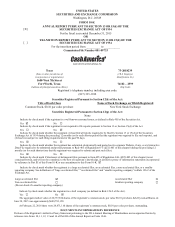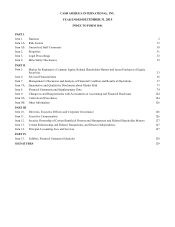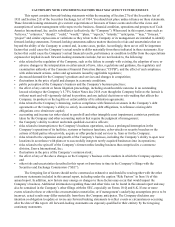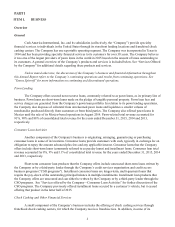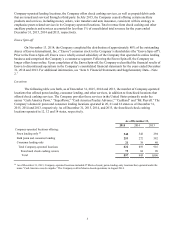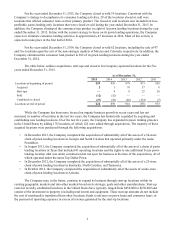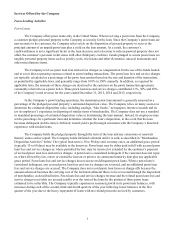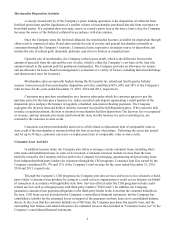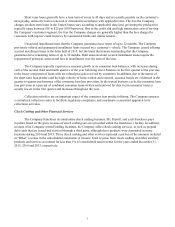Cash America 2015 Annual Report Download - page 9
Download and view the complete annual report
Please find page 9 of the 2015 Cash America annual report below. You can navigate through the pages in the report by either clicking on the pages listed below, or by using the keyword search tool below to find specific information within the annual report.
Services Offered by the Company
Pawn Lending Activities
Pawn Loans
The Company offers pawn loans only in the United States. When receiving a pawn loan from the Company,
a customer pledges personal property to the Company as security for the loan. Since the Company’s pawn loans are
non-recourse to the customer, the Company relies solely on the disposition of pawned property to recover the
principal amount of an unpaid pawn loan plus a yield on the loan amount. As a result, the customer’s
creditworthiness is not a significant factor in the loan decision, and a decision to redeem pawned property does not
affect the customer’s personal credit status with other third-party creditors. Goods pledged to secure pawn loans are
tangible personal property items such as jewelry, tools, televisions and other electronics, musical instruments and
other miscellaneous items.
The Company receives pawn loan fees and service charges as compensation for the use of the funds loaned
and to cover direct operating expenses related to pawn lending transactions. The pawn loan fees and service charges
are typically calculated as a percentage of the pawn loan amount based on the size and duration of the transaction,
as permitted by applicable laws, and generally range from 100% to 350% annually. In addition, as required by
applicable laws, the amounts of these charges are disclosed to the customer on the pawn transaction agreement,
commonly referred to as a pawn ticket. These pawn loan fees and service charges contributed 31%, 30% and 30%
of the Company’s total revenue for the years ended December 31, 2015, 2014 and 2013, respectively.
In the Company’s pawn lending operations, the maximum pawn loan amount is generally assessed as a
percentage of the pledged personal property’s estimated disposition value. The Company relies on many sources to
determine the estimated disposition value, including catalogs, “blue books,” newspapers, internet research and its
(or its employees’) experience in disposing of similar items of merchandise. The Company does not use a standard
or mandated percentage of estimated disposition value in determining the loan amount. Instead, its employees may
set the percentage for a particular item and determine whether the item’s disposition, in the event that the loan
becomes delinquent and the item is forfeited, would yield a profit margin consistent with the Company’s historical
experience with similar items.
The Company holds the pledged property through the term of the loan and any extensions or renewals
thereof, unless earlier repaid. The Company holds forfeited collateral until it is sold, as described in “Merchandise
Disposition Activities” below. The typical loan term is 30 to 90 days and, in many cases, an additional grace period
(typically 10 to 60 days) may be available to the borrower. Pawn loans may be either paid in full with accrued pawn
loan fees and service charges or, where permitted by law, may be renewed or extended by the customer’s payment
of accrued pawn loan fees and service charges. A pawn loan is considered delinquent if the customer does not repay
or, where allowed by law, renew or extend the loan on or prior to its contractual maturity date plus any applicable
grace period. Pawn loan fees and service charges do not accrue on delinquent pawn loans. When a pawn loan is
considered delinquent, any accrued pawn loan fees and service charges are reversed, and no additional pawn loan
fees and service charges are accrued. The Company does not record pawn loan losses or charge-offs because the
amount advanced becomes the carrying cost of the forfeited collateral that is to be recovered through the disposition
of merchandise, as described below. Pawn loan fees and service charges revenue and the related pawn loan fees and
service charges receivable are accrued ratably over the term of the loan for the portion of those pawn loans
estimated to be collectible. The Company typically experiences seasonal growth in its pawn loan balances, with
increases during each of the second, third and fourth quarters of the year following lower balances in the first
quarter of the year due to the heavy repayment of loans with tax refund proceeds received by customers.
5



